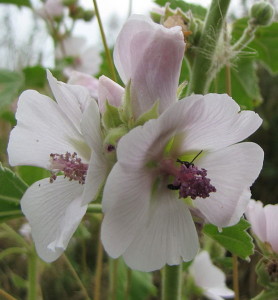I constantly stress the importance of good drainage for successfully growing herbs. Herbs do not like wet feet but every rule has its exception and the exception to the good drainage rule is the marshmallow. As its name implies, it prefers a wet environment.
Marshmallow (Althea officinalis) is native to North Africa where it grows in marshes and salt marshes. It doesn’t mind salinity. The ancient Egyptians made a sweet similar to our marshmallows from its roots and the ancient Romans ate the root as a vegetable.
All of the parts of the plant, the flowers, leaves and root have medicinal properties. The name, Althaea, is derived from a Greek word meaning “to heal” or “to cure”. Marshmallow has been used to treat sore throats and mouth ulcers. The dried root has even been given to teething children to chew on, providing relief to their sore gums. It was also thought to be effective for coughs and bronchial issues. It’s not surprising that such a useful plant spread throughout Europe and Great Britain and then was brought to the New World by European colonists.
Marshmallow is a perennial that is hardy in zones 3 through 7. In the fall, the plant dies back. As it dies back, the dead stems and leaves should be promptly removed to prevent pests from overwintering in your garden or disease developing the following spring. The plants grow 3 to 4 feet tall and sport pink flowers along their stems in August and September. They grow in any type of soil, preferring wet soils but will tolerate some dryness. Like most herbs, they require full sun.
Propagation is by seed and division. Marshmallow will readily self-sow in our garden, but if you are growing from seed, it can be direct sown in the late summer or in the spring. Germination can be erratic. If you want more reliable germination, start your seeds in flats and use cold stratification, putting the flats in your refrigerator for 4 – 6 weeks to mimic winter weather. If you are dividing your plants, they can be divided in either the spring or the fall.
Leaves are best harvested right before the plant flowers in August. The roots should be harvested in the autumn after the plant has finished blooming. If grown from seed, the plants should be at least two years old before harvesting their roots. Both the leaves and the roots can be dried for later used.

